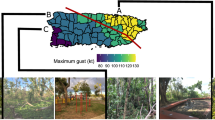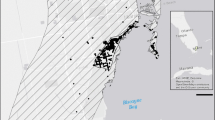Abstract
Urban growth is a strong driver of habitat degradation and loss. In spite of that, a surprising diversity of native species may survive in urban areas. In the La Paz, Bolivia metropolitan area and surroundings, local populations of “viscachas” (Lagidium viscacia) currently survive in small, isolated habitat patches. We assessed 13 study sites in 1999, 2003, and 2007 to document the effects of urban growth on L. viscacia habitats. Degree of disturbance at the study sites increased more between 1999 and 2003 than it did between 2003 and 2007 due to patterns of urban expansion. Using satellite imagery we determined that the urban area increased 566 ha (from 1987 to 2001) mostly due to southward urban area expansion down the valley where the best viscacha habitats were located. Occupied patch area decreased 74 % between 1999 and 2007, accompanied by significant increases in patch edge-to-area ratios. Currently L. viscacia populations in La Paz are experiencing a habitat attrition process. If a current urban expansion plan for La Paz is approved, about 75 % of the remaining habitat may be lost to urban development in a short time, compromising the future viability of this species in the metropolitan area and surroundings. Environmental regulations to control urban growth of the La Paz metropolitan area are urgently required and constitute the only hope for the survival of L. viscacia in the city.


Similar content being viewed by others
References
Arbona JM, Kohl B (2004) City profile La Paz - El Alto. Cities 21:255–265
Cortés A, Rau JR, Miranda E, Jiménez JE (2002) Hábitos alimenticios de Lagidium viscacia y Abrocoma cinerea: roedores sintópicos en ambientes altoandinos del norte de Chile. Rev Chil Hist Nat 75:583–593
Donnelly R, Marzluff JM (2006) Relative importance of habitat quantity, structure, and spatial pattern to birds in urbanizing environments. Urban Ecosyst 9:99–117
Hardy S (2006) Vulnerabilidades, riesgos, elementos esenciales a la escala de la región urbana de La Paz. Institut de Recherche pour le Développement (IRD), La Paz
Hargis CD, Bissonette JA, David JL (1998) The behavior of landscape metrics commonly used in the study of habitat fragmentation. Landsc Ecol 13:167–186
Harrison S (1991) Local extinction in a metapopulation context: an empirical evaluation. Biol J Linn Soc 43:3–16
Knaapen JP, Bottom M, Harms B (1992) Estimating habitat isolation in landscape planning. Landsc Urban Plann 23:1–16
Liberman CM (1991) Geología del valle de La Paz. In: Forno E, Baudoin M (eds) Historia Natural de un Valle de Los Andes: La Paz. Editorial Instituto de Ecología, Universidad Mayor de San Andrés, La Paz, pp 19–26
Lindenmayer DB, Fischer J (2006) Habitat fragmentation and landscape change. Island Press, Washington DC
Lorini JL (1991) Clima. In: Forno E, Baudoin M (eds) Historia Natural de un Valle de Los Andes: La Paz. Editorial Instituto de Ecología, Universidad Mayor de San Andrés, La Paz, pp 27–46
McKinney ML (2002) Urbanization, biodiversity, and conservation. BioScience 52:883–890
McKinney ML (2006) Urbanization as a major cause of biotic homogenization. Biol Conserv 127:247–260
Murcia C (1995) Edge effects in fragmented forests: implications for conservation. Trends Ecol Evol 10:58–62
Obaid TA (2007) State of world population 2007: Unleashing the potential of urban growth. United Nations Population Fund, New York
Pauchard A, Aguayo M, Alaback P (2006) Cuantificando la fragmentación del paisaje: Las métricas y sus significados ecológicos. In: Grez AA, Simonetti JA, Bustamante RO (eds) Biodiversidad en ambientes fragmentados de Chile: Patrones y procesos a diferentes escalas. Editorial Universitaria, Santiago de Chile, pp 41–68
Pearson OP (1948) Life history of mountain viscachas in Peru. J Mammal 29:345–374
PROMETA (2009) Áreas Protegidas Municipales una realidad en Bolivia. Protección del Medio Ambiente Tarija (PROMETA), Tarija
Quinn GP, Keough MJ (2003) Experimental design and data analysis for biologists. Cambridge University Press, Cambridge
Rempel R (2006) Patch Analyst version 3.0. Ministry of Natural Resources, Ontario
Ricketts TH (2001) The matrix matters: effective isolation in fragmented landscapes. Am Nat 158:87–99
Rowlands IW (1974) Mountain viscacha. Symp Zool Soc Lond 34:131–142
Sadik K (1999) The state of world population 1999–6 billion: A time for choices. United Nations Population Fund, New York
Shochat E, Warren PS, Faeth SH, McIntyre NE, Hope D (2006) From patterns to emerging processes in mechanistic urban ecology. Trends Ecol Evol 21:186–191
Tarifa T, Fontúrbel FE, Achá D, Rodríguez J, Molina CI, López MC, Baudoin MR, Buitrón C, Canseco A, García M, Higueras Y, Kopp D, Pacajes J, Romecin P, Urrelo V (2004) Vizcachas (Lagidium viscacia, Chinchillidae) en hábitats fragmentados en la ciudad de La Paz y sus alrededores: bases para su conservación. Ecología en Bolivia 39:53–74
UNICEF-Bolivia (2001) La ocupación del territorio y la urbanización. UNICEF, La Paz
Walker RS (2001) Effects of landscape structure on the distribution of mountain vizcacha (Lagidium viscacia) in the Patagonian steppe. Doctoral thesis, University of Florida, Gainesville
Walker RS, Ackermann G, Schachter-Brodie J, Pancotto V, Novaro AJ (2000) Habitat use by mountain vizcachas (Lagidium viscacia Molina, 1782) in the Patagonia steppe. Mamm Biol 65:293–300
Walker RS, Novaro AJ, Branch LC (2003) Effects of patch attributes, barriers, and distance between patches on the distribution of a rock–dwelling rodent (Lagidium viscacia). Landscape Ecol 18:187–194
Walker RS, Novaro AJ, Branch LC (2007) Functional connectivity defined through cost–distance and genetic analyses: a case study for the rock–dwelling mountain vizcacha (Lagidium viscacia) in Patagonia, Argentina. Landscape Ecol 22:1303–1314
Werner FA, Ledesma KJ, Hidalgo R (2006) Mountain vizcacha (Lagidium cf. peruanum) in Ecuador – first record on Chinchillidae from the Northern Andes. Mastozoología Neotropical 13:271–274
Acknowledgments
We thank Jaime Jiménez, Jaime Rau, and Lyn Branch for their insights on early drafts of our manuscript. We especially thank Eric Yensen for his valuable insights on fragmentation processes as well as help with the English language. Darío Achá, Carlos Molina, Angela Canseco, María René Baudoin, and Carla Barriga assisted in the field. John Marzluff, Gladys Galende, and Jesús Tarifa provided helpful literature. FEF was supported by a doctoral fellowship from the Comisión Nacional de Investigación Científica y Tecnológica (CONICYT).
Author information
Authors and Affiliations
Corresponding author
Rights and permissions
About this article
Cite this article
Fontúrbel, F.E., Tarifa, T. Can a habitat specialist survive urbanization? the case of the viscacha (Lagidium viscacia, Chinchillidae). Urban Ecosyst 17, 163–172 (2014). https://doi.org/10.1007/s11252-013-0314-3
Published:
Issue Date:
DOI: https://doi.org/10.1007/s11252-013-0314-3




